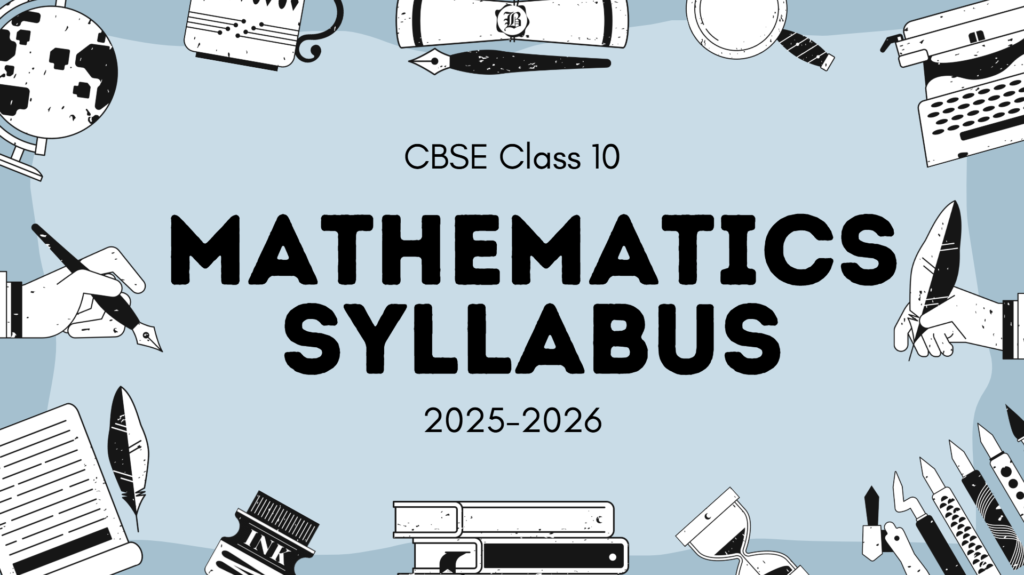
Table of Contents
The CBSE Class 10 Maths syllabus is one of the most important resources for students preparing for board exams. Understanding the syllabus thoroughly helps students organize their study time, focus on key concepts, and plan their revision smartly. It also sets a strong foundation for subjects in higher classes and competitive exams like JEE, NDA, and others.
In this article, we’ll break down the CBSE Class 10 Maths syllabus topic by topic, explain the weightage of each unit, and provide tips to help you make the most of it. Whether you’re a student, teacher, or parent, this guide is designed to make the syllabus crystal clear.
🔍 Overview of the CBSE Class 10 Maths Syllabus
The CBSE Class 10 Maths syllabus is divided into seven major units:
- Number Systems
- Algebra
- Coordinate Geometry
- Geometry
- Trigonometry
- Mensuration
- Statistics and Probability
Each of these units contains chapters that contribute to different types of questions in the board exam—objective, short-answer, and long-answer questions.
📘 Detailed Breakdown of CBSE Class 10 Maths Syllabus
Let’s dive into the complete breakdown of topics and subtopics as per the latest CBSE curriculum for 2024-25.
1. Number Systems (6 Marks)
- Real Numbers
- Euclid’s Division Lemma
- Fundamental Theorem of Arithmetic
- Revisiting Irrational Numbers
- Decimal expansions of rational numbers
2. Algebra (20 Marks)
- Polynomials
- Zeros of a polynomial
- Relationship between zeros and coefficients
- Pair of Linear Equations in Two Variables
- Graphical and algebraic methods of solving
- Substitution and elimination methods
- Quadratic Equations
- Solutions by factorization and formula
- Nature of roots
- Arithmetic Progressions
- nth term, sum of n terms
- Application in real-life problems
3. Coordinate Geometry (6 Marks)
- Distance formula
- Section formula (internal division)
- Concept of coordinate plane
4. Geometry (15 Marks)
- Triangles
- Similarity of triangles
- Pythagoras Theorem and converse
- Circles
- Tangents drawn from an external point
- Properties of tangents
- Constructions
- Division of line segments
- Construction of tangents to a circle
5. Trigonometry (12 Marks)
- Introduction to Trigonometry
- Trigonometric ratios of angles
- Values of standard angles
- Trigonometric identities
- Heights and Distances
- Angle of elevation and depression
- Simple real-world problems
6. Mensuration (10 Marks)
- Areas Related to Circles
- Sector and segment of a circle
- Application problems
- Surface Areas and Volumes
- Cubes, cuboids, cylinders, cones, spheres
- Frustum of a cone
7. Statistics and Probability (11 Marks)
- Statistics
- Mean, median, mode of grouped data
- Cumulative frequency graphs
- Probability
- Simple problems based on single events
🧮 Internal Assessment (20 Marks)
Apart from the theory paper (80 marks), the CBSE Class 10 Maths syllabus includes internal assessment. This typically consists of:
- Periodic Tests – 10 Marks
- Math Lab Activities – 5 Marks
- Portfolio – 5 Marks
Students are encouraged to take internal assessments seriously, as these marks contribute directly to the final grade.
✍️ Tips to Master the CBSE Class 10 Maths Syllabus
1. Start with the Blueprint
Get a copy of the latest CBSE Class 10 Maths syllabus and keep it visible while studying. Knowing which chapters carry more marks helps you prioritize better.
2. Focus on NCERT
The CBSE exam strictly follows the NCERT textbook. Make sure you solve every example and exercise in the book.
3. Solve Previous Year Papers
This is a smart way to understand the pattern of questions and the types of problems that often repeat.
4. Create a Weekly Revision Plan
Divide the CBSE Class 10 Maths syllabus into weekly goals. This prevents last-minute panic and helps retain concepts better.
5. Use Flashcards and Mind Maps
Especially for formulas and theorems, visual tools can make revision faster and more effective.
6. Practice Diagrams and Constructions
For Geometry and Constructions, practice drawing diagrams neatly and accurately using a pencil and ruler.
🧠 Importance of the CBSE Class 10 Maths Syllabus
The CBSE Class 10 Maths syllabus does more than prepare you for exams. It lays the foundation for higher-level mathematics, logical reasoning, and problem-solving skills. Here’s why it matters:
- For Science Stream: Math is mandatory in Physics and Chemistry applications.
- For Commerce: Concepts like statistics and profit-loss carry forward into economics and accounting.
- For Competitive Exams: Exams like JEE, NDA, SSC, and banking exams build on Class 10 level math.
- For Life: Budgeting, measurements, percentages—you use math every day.
📥 Download the CBSE Class 10 Maths Syllabus PDF
The Central Board of Secondary Education (CBSE) regularly updates the curriculum. You can always find the official and updated CBSE Class 10 Maths syllabus on the CBSE Academic Website.
📊 Chapter-wise Weightage (2024-25)
| Unit | Marks |
|---|---|
| Number Systems | 6 |
| Algebra | 20 |
| Coordinate Geometry | 6 |
| Geometry | 15 |
| Trigonometry | 12 |
| Mensuration | 10 |
| Statistics & Probability | 11 |
| Total (Theory) | 80 |
🔚 Final Thoughts
Understanding the CBSE Class 10 Maths syllabus is the first and most important step in preparing effectively for the board exam. It gives you clarity, helps with planning, and allows you to use your time wisely.
From algebra to trigonometry and statistics, the syllabus covers essential math skills that go beyond exams. Stick to the syllabus, use quality resources, and revise regularly. The earlier you start, the more confident you’ll feel walking into that exam room.
So get your notebooks, pens, and calculator ready—because now, you’re not just studying CBSE Class 10 Maths, you’re mastering it.
